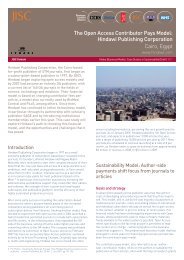A Concise Guide to Researching Audiences - Strategic Content ...
A Concise Guide to Researching Audiences - Strategic Content ...
A Concise Guide to Researching Audiences - Strategic Content ...
Create successful ePaper yourself
Turn your PDF publications into a flip-book with our unique Google optimized e-Paper software.
The <strong>Guide</strong> <strong>to</strong> <strong>Researching</strong> <strong>Audiences</strong><strong>Concise</strong> editionThe project had a well-defined brief for the research, which stated that ‘the Hub lacks a coordinatedstrategic approach <strong>to</strong> qualitative online audience profiling and research… we aim <strong>to</strong> build a more completeunderstanding of the Hub’s online audiences, and use this knowledge <strong>to</strong> take a more strategic user-focusedapproach <strong>to</strong> online delivery’. This brief was underpinned by specific research questions about their onlineaudiences: Who are our audiences? Why do they use our websites? What are their expectations of thewebsites? To what extent are these expectations currently being met?The project used a multi-stranded approach <strong>to</strong> audience research (eg combining online questionnaires, face<strong>to</strong>-faceinterviews, focus groups and web statistics) <strong>to</strong> gather information <strong>to</strong> answer these questions. Thefindings from this project were then used <strong>to</strong> take a more strategic user-focused approach <strong>to</strong> online delivery.For example, the research confirmed that the overwhelming majority of website usage was for planning avisit <strong>to</strong> a museum. However, the website was not a key fac<strong>to</strong>r in the decision <strong>to</strong> visit – the reputation of themuseum in a particular field, location etc were the main fac<strong>to</strong>rs.Following this explora<strong>to</strong>ry research, concrete steps have been agreed that will enable the Hub <strong>to</strong> move<strong>to</strong>wards a common approach <strong>to</strong> collecting data on how online services are received by the audience and thebroader impact that online services have on organisations as a whole. For more information on the LondonMuseums Hub, see the MLA London website (www.mlalondon.org.uk).3.2.2 Audience analysis can be divided in<strong>to</strong> two broad, interdependent categories: assessment of reach anduptake, and assessment of quality and impact. In planning audience research it is helpful <strong>to</strong> decide howimportant each aspect of the analysis is.3.2.3 Research objectives must be set according <strong>to</strong> individual service priorities and context. Starting pointsfor identifying broad aims and framing objectives include service development objectives (eg how canwe extend the reach of our service?) and questions about the audience and non-users (eg who are ouraudience? how do they use our service?). See Figure 3‐1 and Figure 3‐2 for examples.Figure 3‐1: understanding non-usersNON-USERSWHO are they?Target audience – existing audience= non-usersWhich segments of the targetaudience are under-represented?MarketingHOW could wemake them moreaware?WHY are they notusing ourservice?AwarenessWHY can they notaccess it?Not awareAwareAware butcannot accessHAVE they everused our service?UsageAudience satisfactionWHAT did theythink of ourservice?ReasonTechnologicalAuthenticationrequiredWHY do they notuse our service?ReasonEx-usersNeverWHY do they nolonger use ourservice?DisabilitiesNot interestedHappy withalternativePoor publicimageWHY are thealternativespreferred?ReasonNot interestedHappy withalternativeToo slowReasonBetter qualityBetter coverageEasier <strong>to</strong>access3. Planning audience research PAGE 13



